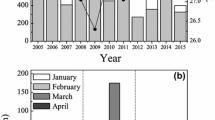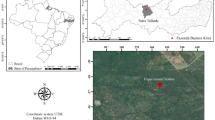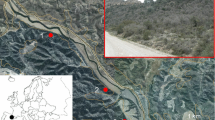Abstract
The water potential (Ψ) daily courses of 9 woody species from Cerrado vegetation in different weather conditions during wet season were observed and analyzed. The adjusting strategies of 9 species could be divided into 3 groups according to Cluster Analysis and based on the data observed on the January 18, March 20 and April 6. The Ψ values of the first group, which included 2 species, were maintained at the higher level consistently. The Ψ values of the second group, which included 5 species, were intermediate level. The Ψ values of the third group, which included 2 species, were kept in the lower level. The Ψ values of all species always kept pace with the weather condition, especially water condition. During the clear day only one Ψ value peak for all species occurred at midday (12∶30–13∶30). When the overcast or raining occurred for a short period, the fluctuation of Ψ values would appear after about 15–30 min responding to the change of weather condition. Even in the same group under the same external circumstance, there was a clear variation of the leaf Ψ values among different species, which showed that the strategy diversity for plant to balance water relation. From January to April, the Ψ values of 9 species reduced in response to the drought condition. The species with the lower values of water saturation deficiency at turgid loss point (W sdtlp) the osmotic potential at saturation (πsat), the osmotic potential at turgid lose point (πtip) or lower predawn water potential (Ψpd) usually had the lower Ψ values at midday. The mechanism of water balance controlled by many systems has been assumed.
Similar content being viewed by others
References
Boyer, J.S. 1989. Water potential and plant metabolism: comments on Dr. P.J. Kramer article hanging concepts regarding plant water relation’ Volume 11, number 7, pp. 565–568, and Dr. J.B. Passioura Response, pp. 569–571. Plant, Cell and Environment,12: 213–216.
Kozlowski, T.T., Kramer, P.J. & Pallardy, S.G. 1991. The physiological ecology of woody plants, London: Academic Press, INC, 248–302
Kramer, P.J. 1988. Changing concepts regarding plant water relations. Plant, Cell and Environment,11:565–568.
Kubiske, M.E. & Abrams, M.D. 1991. Seasonal, diurnal and rehydration-induced variation of pressure-volume relationships inPseudotsuga menziesii. Physiologia Plantarum,83:107–116.
Laker, M.C. Boedt, L.J.J. & Hensley, M. 1987. Predawn leaf water potential as an indicator of plant water stress-with special reference to problem encountered under conditions of higher evaporative demand. International Conference on Measurement of Soil and Plant Water Status, Logan Utah,2:25–29.
Larcher, W. 1995. Physiological plant ecology, third edition. New York, Berlin: Heidelberg, Aufl. Springer-Verlag, 215–264.
Passioura, J.B. 1988. Response to Dr. P.J. Kramerarticle, hanging concepts regarding plant water relation’. Volume 11, number 7, pp. 565–568. Plant, Cell and Environment,11: 569–571.
Pielou, E.C. 1984. The interpretation of ecology data, a primer on classification and ordination. New York, Chichester, Brisbane, Toronto. Singapore: John, Wiley & Sons, A Wiley-interscience Publication, 13–83
Prado, C.H.B.A., Moraes, J.A.P.V. & Mattos, E.A. 1994. Gas exchange and leaf water status in potted plants ofCopaifera langsdorffii, 1, responses to water stress. Photosynthetica,30 (2): 207–213.
Prado, C.H.B.A., Moraes, J.A.P.V. & Mattos, E.A. 1995. Gas exchange and leaf water status in potted plants ofCopaifera langsdorffii, 2, probable influence of low air humidity. Photosynthetica,30(2): 207–213.
Rundel, P.W. 1991. Shrub life-form. Response of Plants to Multiple Stresses (eds Mooney H. A.et al.), San Diego, California. New York, Boston, London, Sydney, Tokyo, Toronto: Academic Press, Inc. 345–370.
Schulze, E.D., Steudle, E., Gollan, T. & Schurr U. 1988. Response to Dr. P. J. Kramer article, hanging concepts regarding plant water relation’ Volume 11, number 7, pp. 565–568. Plant, Cell and Environment,11:573–576
Saltyer, R. O. 1967. Plant-water relationships. London: Academic Press, 35–45
Tazaki, T. Ishihara, K. & Ushijima, T. 1980. Influence of water stress on photosynthesis and productivity of plants in humid areas. In: Adaptation of Plants to Water and High Temperature (eds Turner N.C. & Kramer P.J.). New York: John Wiley, 309–321
Author information
Authors and Affiliations
Additional information
Zhang Wenhui, male, born in Dec. 1955, professor of Northwest Forestry College, Shaanxi 712100, P.R. China
Responsible: Zhu Hong
Rights and permissions
About this article
Cite this article
Wenhui, Z., Prado, C.H.B.A. & Ruiping, M. Analysis on the daily courses of water potential of nine woody species from Cerrado vegetation during wet season. Journal of Forestry Research 11, 7–12 (2000). https://doi.org/10.1007/BF02855487
Received:
Published:
Issue Date:
DOI: https://doi.org/10.1007/BF02855487




